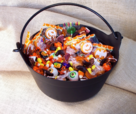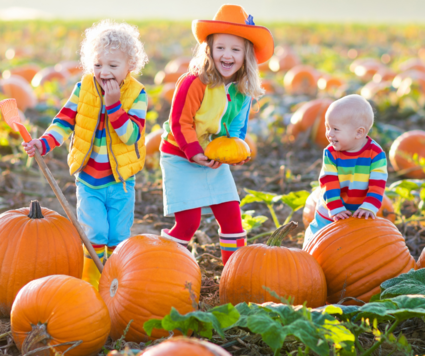WATER QUALITY IMPROVEMENTS

Scary Halloween Waste Facts & Pollution Prevention Tips
Halloween is one of our most celebrated holidays with fun costumes, tasty candy, and spooky decorations! But it’s also one of the least environmentally friendly ones. Candy wrappers, decorations, and costumes can not only end up in our landfills but also pollute our waterways if they’re left on the ground. Unlike the sewer system which treats water, any litter that goes into the storm drain system can go untreated into our creeks, rivers, bays, and ocean.
Scary Halloween Waste Facts
- 83% of Halloween costumes use non-recyclable plastic, equivalent to around 2,000 tons of plastic waste and can take up to 20-200 years to decompose. Over time plastic waste turns into microplastics which are difficult to recycle because they consist of mixed materials such as feathers, fake hair, and plastic parts. Plastic also releases harmful toxins into the environment.
- Americans spend around $2.36B on plastic single-use decorations each year that when thrown away, can be damaging to our waterways.
- 40% of consumers buy pumpkins to carve for Halloween but 60% of them just throw them away afterwards. This adds up to 1 billion pounds of pumpkins sent to landfills annually.
- This year, Americans will buy approximately 600 million pounds of Halloween candy, with the average trick-or-treater generating 1 pound of trash. Most Halloween waste comes from candy wrappers that contain plastic which is nearly impossible to recycle.
|
Pollution Prevention and Waste Reduction Tips
From costumes, to candy wrappers, to decorations, to carving pumpkins – all can contribute to excess waste and water pollution. Being more mindful of our Halloween activities and actions can help to prevent these Halloween pollutants from entering our storm drains and harming our waterways.
-
Reduce/Rethink Halloween Waste
-
Treats – Look for goodies with minimal packaging or those packaged in recycled or recyclable materials. Better yet, bake your own Halloween treats and use biodegradable or reusable wrapping. You can also use a reusable bag or old pillowcase instead of a plastic bucket to collect trick or treat goodies. Check out the Port of San Diego’s #thatsmybay Lil’ Wrapper to Littered Wrapper video on how wrappers and other trash travel through our watersheds and into the ocean.
-
Decorations – Halloween decorations are the most wasteful part of Halloween as they tend to contain excessive amounts of single-use plastics which, when thrown away, can be damaging to the environment. Reuse decorations from previous years, buy second-hand, or get creative and make your own. If you do end up buying them from retailers, check to see if the decorations are recyclable or of good enough quality to use again next year.
-
Costumes – Repurpose and recycle your Halloween costume. You can make your own eco-friendly Halloween accessories using materials like cardboard, wood, string, sheets, and old clothes. Additionally, participate in a local costume swap or get your costume from a thrift store. Not only is it more eco-friendly, but you can also find unique pieces. And remember to donate this year’s costume if you don’t want to store it or use it again.
-
Pumpkins – Reduce the number of pumpkins you buy or use the leftovers from the carvings to make soups, pies, and other tasty treats. Alternatively, you can take unwanted pumpkins to select local farms, where they will be fed to pigs and other animals instead of going to waste.
-
Batteries – A great way to reduce your battery waste this Halloween is to choose battery-free decorations and costumes altogether. If you are going to use batteries, make sure you’re disposing of them properly at your nearest household hazardous waste disposal facility.
-
Properly Dispose of Litter/Organic Waste
-
Trash and Recycling Bins – Many components of Halloween costumes and decorations are made of plastic. Also, holiday festivities may include entertaining using single-use bottles and disposable foodware. Be sure to place trash and recyclables in their appropriate bins and secure the lids to make sure items don’t fall out or get blown by the wind. This helps prevent these pollutants making their way into our stormdrain system, eventually reaching our inland waterways and ocean. To cut down on party waste, use regular dishes or buy biodegradable ones and use a marker to identify cups so party-goers can keep track.
-
Pumpkins/Organic Waste – When pumpkins are sent to landfills, they decompose and produce methane which is an extremely harmful greenhouse gas. Properly dispose of unwanted pumpkins by putting them in your yard waste bin or composting them yourself. Just make sure they are clean, unpainted, and free of decorations or lights. Residents with painted pumpkins can dispose of them in their general waste bins.
The County wishes its residents a fun, safe, and pollution-free Halloween. Check out more green Halloween tips here and other ways to prevent stormwater pollution at the County’s Watershed Protection Program webpage.

|